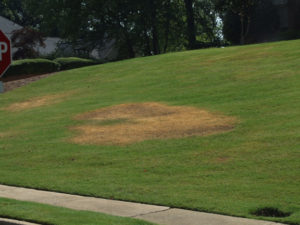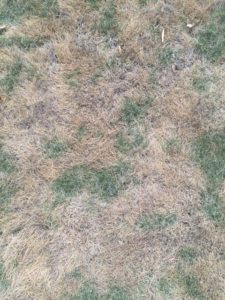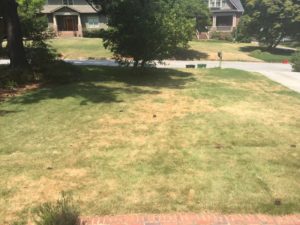


Don’t rely on the rainfall. It is just too variable.
Initially, water those areas heavily to re-hydrate. Its best to do this by hand to ensure the areas get completely re-hydrated. Flood the areas with water. The turf will recover but It needs a couple inches to begin recovery.
Your normal watering profile for all your turf, and ornamental trees and shrubs, should be 1″ per week applied in a single application each week. Do not use the every third day/ 20 minutes per zone regimen that is used by most irrigation contractors and landscapers. You’ll lose ~ 80% of your water to evaporation. If we stay above 95 degrees then water 2 times per week to get 2 total inches per week (1″ per watering). This watering profile allows the water to penetrate more deeply encouraging deeper root systems. It is best to water between 9 PM and 8 AM.
Measure your output for each zone to determine how much time is needed to get 1″ of water. (use a rain gauge, tuna can,cake pan or something with straight sides). It usually takes around 1 hour per zone to get the 1″ of water but every system is different so you should check each zone to determine output. This just needs to be done one time. The time to water output is linear so if you get 1/2″ in 30 minutes you’ll get 1″ in 60 minutes.
If we get 1″ of rainfall (recorded by your gauge) then you are good for the week and won’t need to water, unless the temps are above 95 degrees.
Finally, when the irrigation is running, check the areas that are showing drought stress. We find, in many cases, that the irrigation heads are not adjusted correctly and the the spots are being missed or just not adequately watered due to sprinkler overthrow. You may need to feather the water stream slightly to be sure the dry spots are receiving adequate water.
If you have been using the 1″ per week, one time per week watering profile and still have some brown areas then set up an small sprinkler and water those hot spots. Hot spots can be due to areas that have a different soil profile (such as sand) or rocks or heavy compaction. Regardless of what causes them, they result in areas that dry out faster than their surroundings.
Application of Hydretain ( http://www.domyownpestcontrol.com/hydretain-rts-p-8295.html?gclid=CJyvzIrW680CFZIvgQod7zUMCw) or Lesco Moisture manager (any John Deere nursery) can also greatly improve water relations in landscape and lawn. I use these products on my lawn 1 to 2 times per year to enhance watering efficiency.
The drought damaged areas will recover over time if you follow the watering profile above.
« Back to Glossary Index